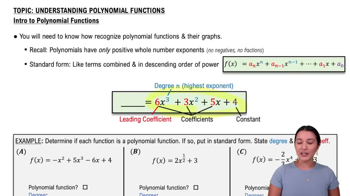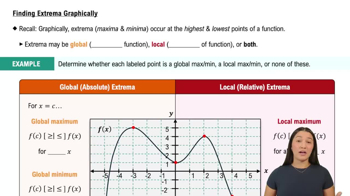Table of contents
- 0. Functions7h 52m
- Introduction to Functions16m
- Piecewise Functions10m
- Properties of Functions9m
- Common Functions1h 8m
- Transformations5m
- Combining Functions27m
- Exponent rules32m
- Exponential Functions28m
- Logarithmic Functions24m
- Properties of Logarithms34m
- Exponential & Logarithmic Equations35m
- Introduction to Trigonometric Functions38m
- Graphs of Trigonometric Functions44m
- Trigonometric Identities47m
- Inverse Trigonometric Functions48m
- 1. Limits and Continuity2h 2m
- 2. Intro to Derivatives1h 33m
- 3. Techniques of Differentiation3h 18m
- 4. Applications of Derivatives2h 38m
- 5. Graphical Applications of Derivatives6h 2m
- 6. Derivatives of Inverse, Exponential, & Logarithmic Functions2h 37m
- 7. Antiderivatives & Indefinite Integrals1h 26m
- 8. Definite Integrals4h 44m
- 9. Graphical Applications of Integrals2h 27m
- 10. Physics Applications of Integrals 2h 22m
5. Graphical Applications of Derivatives
Intro to Extrema
Problem 4.1.73
Textbook Question
Trajectory high point A stone is launched vertically upward from a cliff 192 ft above the ground at a speed of 64 ft/s. Its height above the ground t seconds after the launch is given by s = -16t² + 64t + 192, for 0 ≤ t ≤ 6. When does the stone reach its maximum height?
 Verified step by step guidance
Verified step by step guidance1
Identify the function that represents the height of the stone above the ground: \( s(t) = -16t^2 + 64t + 192 \). This is a quadratic function, which represents a parabola.
Recognize that the maximum height of the stone corresponds to the vertex of the parabola. For a quadratic function \( ax^2 + bx + c \), the vertex occurs at \( t = -\frac{b}{2a} \).
Substitute the values of \( a \) and \( b \) from the function \( s(t) = -16t^2 + 64t + 192 \) into the vertex formula: \( a = -16 \) and \( b = 64 \).
Calculate the time \( t \) at which the stone reaches its maximum height using the formula: \( t = -\frac{64}{2(-16)} \).
Verify that the calculated time \( t \) is within the given interval \( 0 \leq t \leq 6 \) to ensure it is a valid solution for the problem.
 Verified video answer for a similar problem:
Verified video answer for a similar problem:This video solution was recommended by our tutors as helpful for the problem above
Video duration:
2mPlay a video:
Was this helpful?
Key Concepts
Here are the essential concepts you must grasp in order to answer the question correctly.
Quadratic Functions
The height of the stone is modeled by a quadratic function, which is a polynomial of degree two. Quadratic functions have a parabolic shape and can be expressed in the form s(t) = at² + bt + c. The coefficients a, b, and c determine the direction and position of the parabola, with 'a' indicating whether it opens upwards or downwards.
Recommended video:

Introduction to Polynomial Functions
Vertex of a Parabola
The maximum height of the stone corresponds to the vertex of the parabola represented by the quadratic function. For a downward-opening parabola (where a < 0), the vertex can be found using the formula t = -b/(2a). This point gives the time at which the maximum height occurs, which is crucial for solving the problem.
Recommended video:

Properties of Parabolas
Calculus and Optimization
Calculus provides tools for finding maximum and minimum values of functions, which is essential in this context. By taking the derivative of the height function and setting it to zero, we can find critical points that indicate where the maximum height occurs. This process is part of optimization, a key application of calculus in real-world scenarios.
Recommended video:

Intro to Applied Optimization: Maximizing Area

 5:58m
5:58mWatch next
Master Finding Extrema Graphically with a bite sized video explanation from Callie
Start learning





